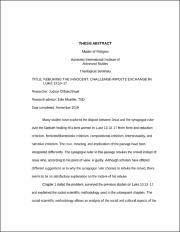| dc.description.abstract | Many studies have explored the dispute between Jesus and the synagogue ruler over the Sabbath healing of a bent woman in Luke 13:10–17 from form and redaction criticism, feminist/liberationist criticism, compositional criticism, intertextuality, and narrative criticism. The crux, meaning, and implication of the passage have been interpreted differently. The synagogue ruler in this passage rebukes the crowd instead of Jesus who, according to his point of view, is guilty. Although scholars have offered different suggestions as to why the synagogue ruler chooses to rebuke the crowd, there seems to be no satisfactory explanation on the motive of his rebuke.
Chapter 1 stated the problem, surveyed the previous studies on Luke 10:13–17, and explained the social-scientific methodology used in the subsequent chapters. The social-scientific methodology allows an analysis of the social and cultural aspects of the
biblical passage by utilizing the viewpoints, concept, models, and data of the social sciences. So, this study employed the honor-shame model proposed by the social-scientific biblical scholars. To avoid the usual pitfalls of thought, namely, superficiality and inaccuracy, this study followed the general laws of scientific steps: (1) postulate a model; (2) test and modify, if necessary, the model; and (3) apply the model.
Chapter 2 merged and implemented the first and second steps of the scientific steps. It presented a definition and explanation of honor-shame and its components. It also analyzed the honor-shame phenomenon in the Lukan narrative to show that the honor-shame model was suitable for analyzing the text under consideration. Chapter 3 executed the third step of the scientific step. It examined the characters, events, settings, and interactions in Luke 13:10–17 in terms of honor and shame to address the problems of this study. It then presented the social-scientific perspective of Luke 13:10–17.
Chapter 4 was the summary and result of this study. The study concluded that Luke 13:10–17 displays a careful and meaningful composition. The honor-shame components influence how Luke retells and structures the story. The social values and the nature of the challenge-riposte shed light on why the synagogue ruler rebukes the crowd instead of Jesus. Since the public opinion is the determiner of honor in a collectivistic society where this interaction takes place, the synagogue ruler challenges the claim of this honorable figure, Jesus, publicly. Therefore, by rebuking the crowd, he publicly challenges the honor of Jesus in aiming to enhance his honor. | en_US |

